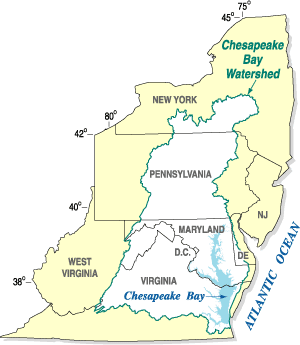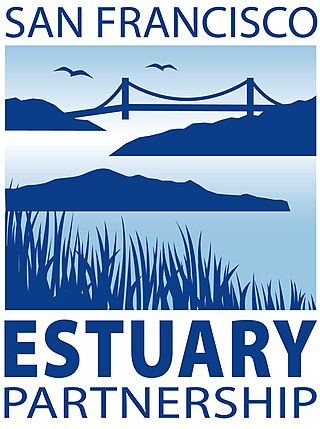
The Chesapeake Bay is the largest estuary in the United States. The Bay is located in the Mid-Atlantic region and is primarily separated from the Atlantic Ocean by the Delmarva Peninsula, including parts of the Eastern Shore of Maryland, the Eastern Shore of Virginia, and the state of Delaware. The mouth of the Bay at its southern point is located between Cape Henry and Cape Charles. With its northern portion in Maryland and the southern part in Virginia, the Chesapeake Bay is a very important feature for the ecology and economy of those two states, as well as others surrounding within its watershed. More than 150 major rivers and streams flow into the Bay's 64,299-square-mile (166,534 km2) drainage basin, which covers parts of six states, New York, Pennsylvania, Delaware, Maryland, Virginia, and West Virginia, and all of Washington, D.C.

The National Estuarine Research Reserve System is a network of 30 protected areas established by partnerships between the National Oceanic and Atmospheric Administration (NOAA) and coastal states. The reserves represent different biogeographic regions of the United States. The National Estuarine Research Reserve System protects more than 1.3 million acres of coastal and estuarine habitats for long-term research, water-quality monitoring, education, and coastal stewardship.
The National Ocean Service (NOS) is an office within the U.S. Department of Commerce, National Oceanic and Atmospheric Administration (NOAA). It is responsible for preserving and enhancing the nation's coastal resources and ecosystems along approximately 95,000 miles (153,000 km) of shoreline, that is bordering 3,500,000 square miles (9,100,000 km2) of coastal, Great Lakes and ocean waters. Its mission is to "provide science-based solutions through collaborative partnerships to address evolving economic, environmental, and social pressures on our oceans and coasts." The office works with partnered agencies to ensure that ocean and coastal areas are safe, healthy, and productive. It`s projects focus on working to ensure safe and efficient marine transportation, promoting the protection of coastal communities, conserving marine and coastal places. It employs 1,700 scientists, natural resource managers, and specialists in many different fields. The National Ocean Service was previously known as the National Ocean Survey until it was renamed in 1983.

The California State Coastal Conservancy is a non-regulatory state agency in California established in 1976 to enhance coastal resources and public access to the coast. The CSCC is a department of the California Natural Resources Agency. The agency's work is conducted along the entirety of the California coast, including the interior San Francisco Bay and is responsible for the planning and coordination of federal land sales to acquire into state land as well as award grant funding for improvement projects. The Board of Directors for the agency is made up of seven members who are appointed by the Governor of California and approved by the California Legislature, members of the California State Assembly and California State Senate engage and provide oversight within their legislative capacity.

The Chesapeake Bay Program is the regional partnership that directs and conducts the restoration of the Chesapeake Bay in the United States. As a partnership, the Chesapeake Bay Program brings together members of various state, federal, academic and local watershed organizations to build and adopt policies that support Chesapeake Bay restoration. By combining the resources and unique strengths of each individual organization, the Chesapeake Bay Program is able to follow a unified plan for restoration. The program office is located in Annapolis, Maryland.
Rookery Bay Reserve protects 110,000 acres of coastal lands and waters at the northern end of the Ten Thousand Islands on the gulf coast of Florida, Rookery Bay National Estuarine Research Reserve represents one of the few remaining undisturbed mangrove estuaries in North America.
The Water Resources Development Act of 1996 is part of Pub. L.Tooltip Public Law 104–303 (text)(PDF), was enacted by Congress of the United States on October 12, 1996. Most of the provisions of WRDA 1996 are administered by the United States Army Corps of Engineers.
The Water Resources Development Act of 1992, Pub. L.Tooltip Public Law 102–580, was enacted by Congress of the United States on October 31, 1992. Most of the provisions of WRDA 1992 are administered by the United States Army Corps of Engineers.
The Water Resources Development Act of 1999, Pub. L.Tooltip Public Law 106–53 (text)(PDF), was enacted by Congress of the United States on August 17, 1999. Most of the provisions of WRDA 1999 are administered by the United States Army Corps of Engineers.
The Water Resources Development Act of 2000, Pub. L.Tooltip Public Law 106–541 (text)(PDF), was enacted by Congress of the United States on December 11, 2000. Most of the provisions of WRDA 2000 are administered by the United States Army Corps of Engineers.

The Coastal Wetlands Planning, Protection and Restoration Act (CWPPRA) was passed by Congress in 1990 to fund wetland enhancement. In cooperation with multiple government agencies, CWPPRA is moving forward to restore the lost wetlands of the Gulf Coast, as well as protecting the wetlands from future deterioration. The scope of the mission is not simply for the restoration of Louisiana's Wetlands, but also the research and implementation of preventative measures for wetlands preservation.

The Partnership for the Delaware Estuary (PDE) is a regional nonprofit organization working to protect and enhance the Delaware Estuary, where fresh water from the Delaware River mixes with salt water from the Atlantic Ocean. Established in 1996, its mission is to lead science-based and collaborative efforts to improve the tidal Delaware River and Delaware Bay, which spans Delaware, New Jersey, and Pennsylvania.
Restore America's Estuaries (RAE) is a national 501(c)(3) non-profit conservation organization dedicated to preserving the nation's network of estuaries through coastal protection and restoration projects which promote the richness and diversity of coastal life. Based in Arlington, VA with staff in Seattle, Colorado, and Florida, Restore America's Estuaries is an alliance of eleven community-based coastal conservation organizations that includes the American Littoral Society (ALS), Chesapeake Bay Foundation (CBF), Coalition to Restore Coastal Louisiana (CRCL), Conservation Law Foundation (CLF), Galveston Bay Foundation (GBF), North Carolina Coastal Federation (NCCF), Save The Bay – San Francisco (STB-SF), EarthCorps, Save The Bay – Narragansett Bay (STB-NB), Save the Sound (STS) - a program of Connecticut Fund for the Environment, and Tampa Bay Watch (TBW).

The Water Quality Control Policy for the Enclosed Bays and Estuaries of California is published by the California State Water Resources Control Board as guidelines to prevent water quality degradation. The policy is revised as needed.

The San Francisco Estuary Partnership (Partnership) is one of the 28 National Estuary Programs created in the 1987 Amendments to the Clean Water Act. The Partnership is a non-regulatory federal-state-local collaboration working to restore water quality and manage the natural resources of the San Francisco Bay-Sacramento–San Joaquin River Delta estuary. The Partnership works with over 100 municipalities, non-profits, governmental agencies, and businesses and helps develop, find funding for, and implement over 40 projects and programs aimed at improving the health of the estuary. The partnership either directly implements these projects, or administers and manages grants, holds educational workshops and highlights project results. The Partnership is also the official representative for the San Francisco Bay region to the Most Beautiful Bays in the World.

The U.S. National Oceanic and Atmospheric Administration (NOAA) National Status and Trends (NS&T) Mussel Watch Program is a water contaminant monitoring program that started in 1986..The program was inspired by Dr. Ed Goldberg at Scripps Institute of Oceanography, but was conceived and designed at a workshop sponsored by NOAA, held at Battelle Ocean Sciences in 1984, and led by Dr. Paul D. Boehm. It is the longest running continuous contaminant monitoring program of its kind in the United States. Mussel Watch monitors the concentration of contaminants in bivalves and sediments in the coastal waters of the U.S., including the Great Lakes, to monitor bivalve health and by extension the health of their local and regional environment.
The Beaches Environmental Assessment and Coastal Health Act of 2000, or BEACH Act, is a United States federal statute that sets national standards for recreational water testing and authorizes grants to pay for beach monitoring programs at state and federal levels. The Act was signed by President Bill Clinton on October 10, 2000. The law amends the Clean Water Act and requires the Environmental Protection Agency (EPA) to set standard criteria for testing, monitoring, and notifying the public of possible pollution within coastal recreational waters. Water pollution levels are required to be monitored regularly for bacteria, such as Escherichia coli (E.coli), and other pathogen indicators. Agencies at local, state, and federal levels report and monitor the levels and post warning signs as necessary.

Climate change in Delaware encompasses the effects of climate change, attributed to man-made increases in atmospheric carbon dioxide, in the U.S. state of Delaware.
Terrebonne Basin is an abandoned delta complex, in Terrebonne Parish, Louisiana. The area is identified by thick sections of unconsolidated sediments that are undergoing dewatering and compaction which contributes to high subsidence. There is a network of old distributary ridges, associated with past distributaries of the Mississippi River, extending south from Houma, Louisiana into the Gulf of Mexico.











